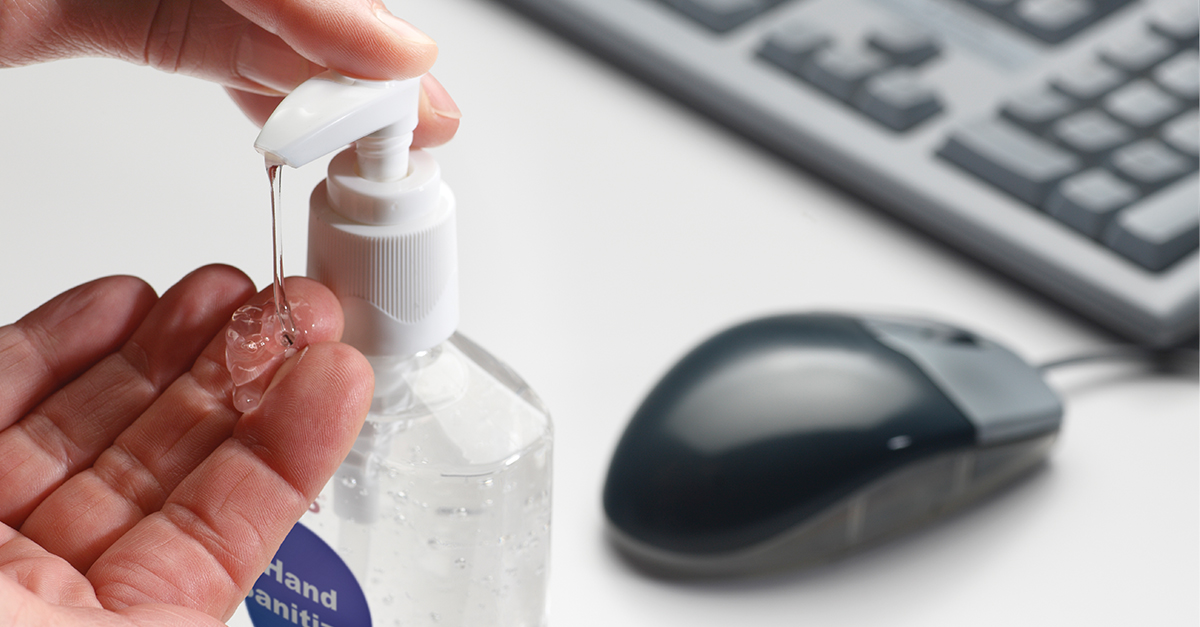This year’s flu season has been worse than normal, and experts are warning that the current flu vaccine may only be 10 percent effective. With this in mind, and given that on any given workday employees use their hands to type up reports, shake hands with new clients, open doors, and share community spaces, it might be a good idea to put some extra hand hygiene solutions in place for your facility.
While washing hands with soap and water is the best way to ensure hands are properly washed and rid of germs, it isn’t always a viable option. However, there is a simple solution: hand sanitizer. According to the World Health Organization (who) and the U.S. Centers for Disease Control and Prevention (CDC), hand sanitizer is one of the best tools available to help prevent the spread of germs. By placing hand sanitizer in strategic locations throughout the facility, you can encourage employees to improve their hand hygiene and create a healthier indoor environment.
Key Locations for Hand Sanitizer
The best way to remind employees to use hand sanitizer is by making it easily accessible and always placing it within sight. It’s important to place hand sanitizer near and around high-touch surfaces and communal areas, including:
Restrooms. A 2016 Bradley Corp. survey of more than 1,000 adults found 67 percent of respondents admitted to skipping soap and just rinsing with water, and 82 percent said they had seen others skip handwashing, as well. This makes it extra important to provide hand sanitizer in the restroom. If employees are in a rush and don’t think to stop and rinse with soap and water, providing a backup option near sinks and doors ensures germs don’t escape the restroom.
Entrances and exits. A single doorknob could potentially be the cause of a widespread illness in the workplace. In fact, as reported by CBS, new research showed that within two to four hours, a virus placed on a doorknob was picked up by 40 to 60 percent of workers and visitors within the facility. In addition to frequently disinfecting doorknobs, light switches, and other high-touch surfaces, make sure to provide a hand sanitizing station near entrances and exits to limit the spread of infection.
Cafeterias, food courts, and break rooms. One of the germiest hotspots in an office is the breakroom and kitchen, and if food is consumed with germ-ridden hands, it’s easy to digest the germs and become infected with several diseases. Although hand sanitizer is not a replacement for hand washing, it can help eliminate certain germs in these areas.
Meeting rooms. Meeting rooms are often packed with employees, clients, and other visitors who exchange handshakes, thus swapping germs. Providing guests and employees with an easy-to-access hand sanitizing station, either near the meeting room door or at the table, allows them to safeguard their hands against germs before and after the meeting takes place.
Employee desks. Desks, phones, computer keyboards, and computer mice are key germ transfer points because people touch them so often. Considering that employees spend the majority of their day at their desks where they also eat, drink, and even cough and sneeze, desks can become a hotspot for germs to reside. Placing individual hand sanitizers at desks keeps hand hygiene within reach.
Transaction counters. In one study published by PLOS ONE, researchers swabbed $1 bills from a bank and discovered hundreds of species of microorganisms living on them. Additional research has found pathogens such as E. coli, salmonella, and staphylococcus aureus on paper money, which all could lead to serious illness. Keeping hand sanitizer near transaction areas, such as the cafeteria check-out counter, reminds people to engage in hand hygiene when it’s needed most.
Encouraging Hand Hygiene
While having hand sanitizer easily accessible is essential to improving the health of your workers, it’s only beneficial if workers regularly use them. Provide posters, leaflets, internal newsletters, and information boards near dispensers with reminders to clean hands, and offer quick, easy facts about hand hygiene. These materials should also include information on how to properly use and apply hand sanitizer according to the method recommended by who to ensure the correct amount is used and spread to cover all surfaces of both hands. Additionally, employers should offer educational seminars and meetings throughout the year to teach and remind employees on how they can improve their health with hand hygiene best practices.
Lead by Example
Using hand sanitizer reduces microbial counts and kills many harmful germs that could infect workers with the flu and other viruses. In order to keep the workplace a healthy and thriving environment, it’s critical that employers take into account the health of its employees. Providing hand sanitizer for employees, at desks and in communal areas, is just as essential as providing the right equipment and tools to do their job.
As an employer, it’s important to lead change with an example. Encourage workers to use sanitizer often by doing so yourself. Don’t forget to stock up on hand hygiene refills during the cold and flu season as well. Lastly, it’s important to remind workers to take a sick day when necessary in order to keep germs away from the office and other healthy workers.




